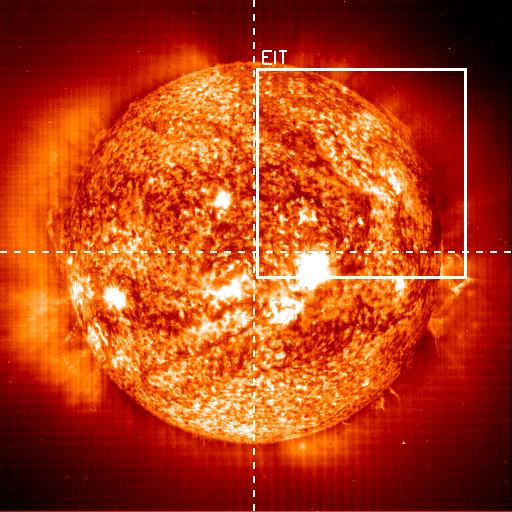 |
High-cadence synoptic program of the Extreme-ultraviolet Imaging Telescope (''Shutterless'') |
| Contents |
| Guidelines and rules | First campaigns evaluation |
| Procedure definitions and options | Data pre-processing |
Scientific Aim
The scientific aim of the EIT high-cadence synoptic program is to monitor long-term changes in the small-scale dynamics of all kinds of solar structures (Active Regions, Quiet Sun, Coronal Holes, etc.), using high-cadence sequences made by the Extreme-ultraviolet Imaging Telescope (EIT). The program is thus planned on the long term (need for regular time intervals of 1 to 3 months), and should eventually last for years until EIT or SOHO dies.
Program Characteristics
 We need a wide field of view to include as many (preferably all) kinds of solar regions as possible, including the solar limb. Our basic field of view is thus essentially a quarter-disk (see Figure): one corner is near disk center and the outer edges are just beyond the limb at the pole and equator.
We need a wide field of view to include as many (preferably all) kinds of solar regions as possible, including the solar limb. Our basic field of view is thus essentially a quarter-disk (see Figure): one corner is near disk center and the outer edges are just beyond the limb at the pole and equator.
With such a field of view and using the shutterless mode of EIT, we can achieve a 68s cadence with an effective exposure quite larger than the standard synoptic exposures (best for CH and QS).
Based on instrument safety concerns (radiation induced aging), the compromise for the baseline duration was set to 2 hours.
As we want to monitor the Transition Region as well as the corona, we run the sequences alternately in 2 bandpasses: 304Å and 195Å (with occasionally a third one: 171Å). We started with a 304Å sequence in December 2000.
Contacts: Dr. Susanna Parenti or Dr. Frédéric Clette
Some movies (uncalibrated) an images from the past campaigns are available by clicking on the links.
| Most recent campaigns | ||||||||||||||||||||||||||||||||||||||||||||||||||||||||||||||||||||||||||||||||||||||||||||||||||
|

